Financial Accounting and Reporting: Revaluation and Shareholders
VerifiedAdded on 2020/03/23
|8
|2332
|112
Report
AI Summary
This report delves into the intricacies of financial accounting and reporting, focusing on the critical aspect of asset revaluation. It explores the motivations behind directors' decisions regarding non-revaluation of equipment, plant, and property, examining the potential impacts on financial statements. The report further investigates the adverse consequences of non-revaluation on shareholder wealth, emphasizing the importance of fair value representation. An in-depth analysis of Amcor Limited's approach to equipment, property, and plant valuation is provided, referencing relevant accounting standards like AASB and IFRS. The report highlights the significance of revaluation in presenting a true and fair view of a company's financial position, offering valuable insights for students and professionals alike. The report also emphasizes the importance of accurate asset valuation for informed decision-making by investors and stakeholders, underscoring the potential for misguidance when assets are not revalued to reflect market values.

Running head: FINANCIAL ACCOUNTING AND REPORTING
Financial accounting and reporting
Name of the student
Name of the student
Author note
Financial accounting and reporting
Name of the student
Name of the student
Author note
Paraphrase This Document
Need a fresh take? Get an instant paraphrase of this document with our AI Paraphraser
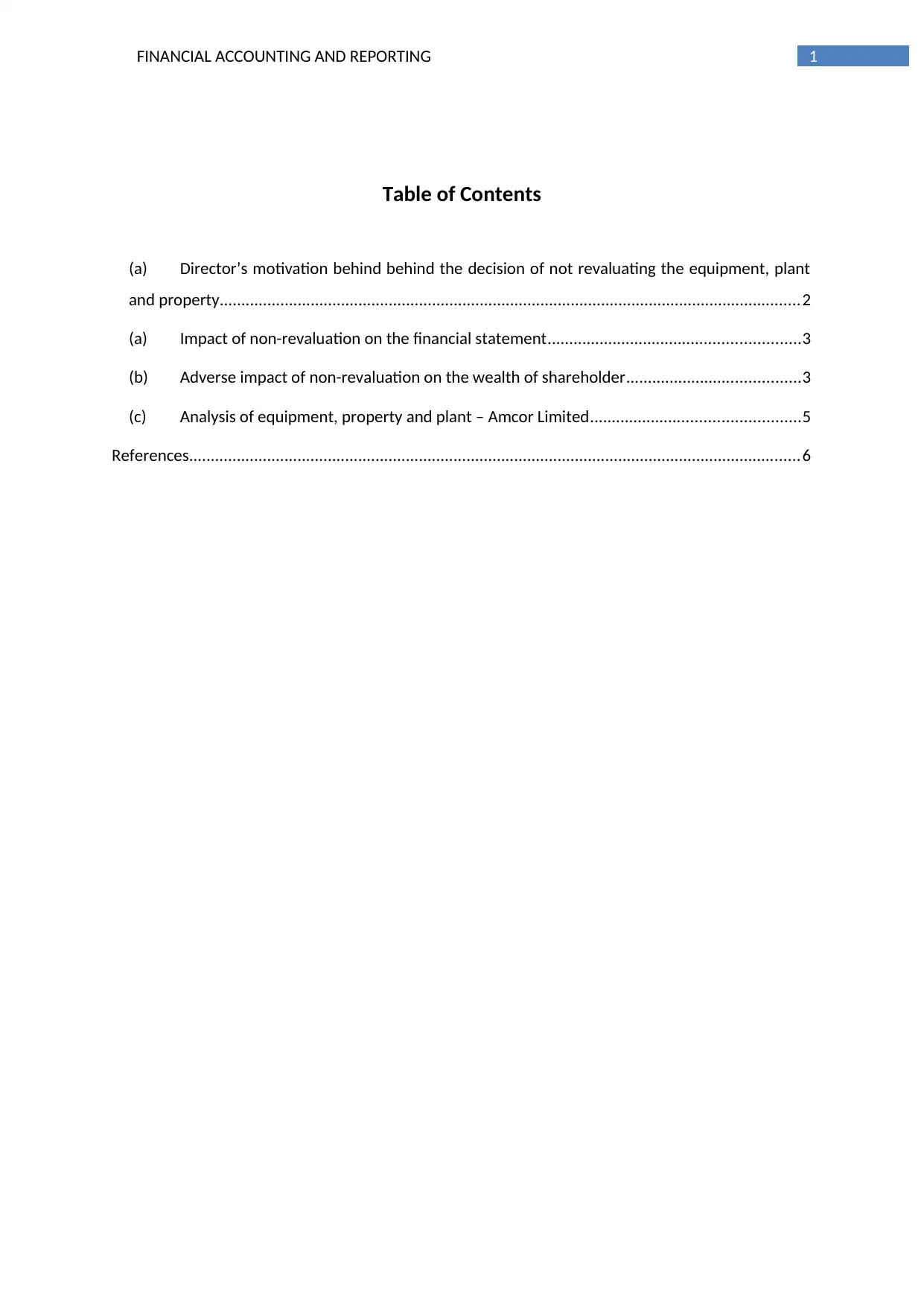
1FINANCIAL ACCOUNTING AND REPORTING
Table of Contents
(a) Director’s motivation behind behind the decision of not revaluating the equipment, plant
and property......................................................................................................................................2
(a) Impact of non-revaluation on the financial statement..........................................................3
(b) Adverse impact of non-revaluation on the wealth of shareholder........................................3
(c) Analysis of equipment, property and plant – Amcor Limited................................................5
References.............................................................................................................................................6
Table of Contents
(a) Director’s motivation behind behind the decision of not revaluating the equipment, plant
and property......................................................................................................................................2
(a) Impact of non-revaluation on the financial statement..........................................................3
(b) Adverse impact of non-revaluation on the wealth of shareholder........................................3
(c) Analysis of equipment, property and plant – Amcor Limited................................................5
References.............................................................................................................................................6
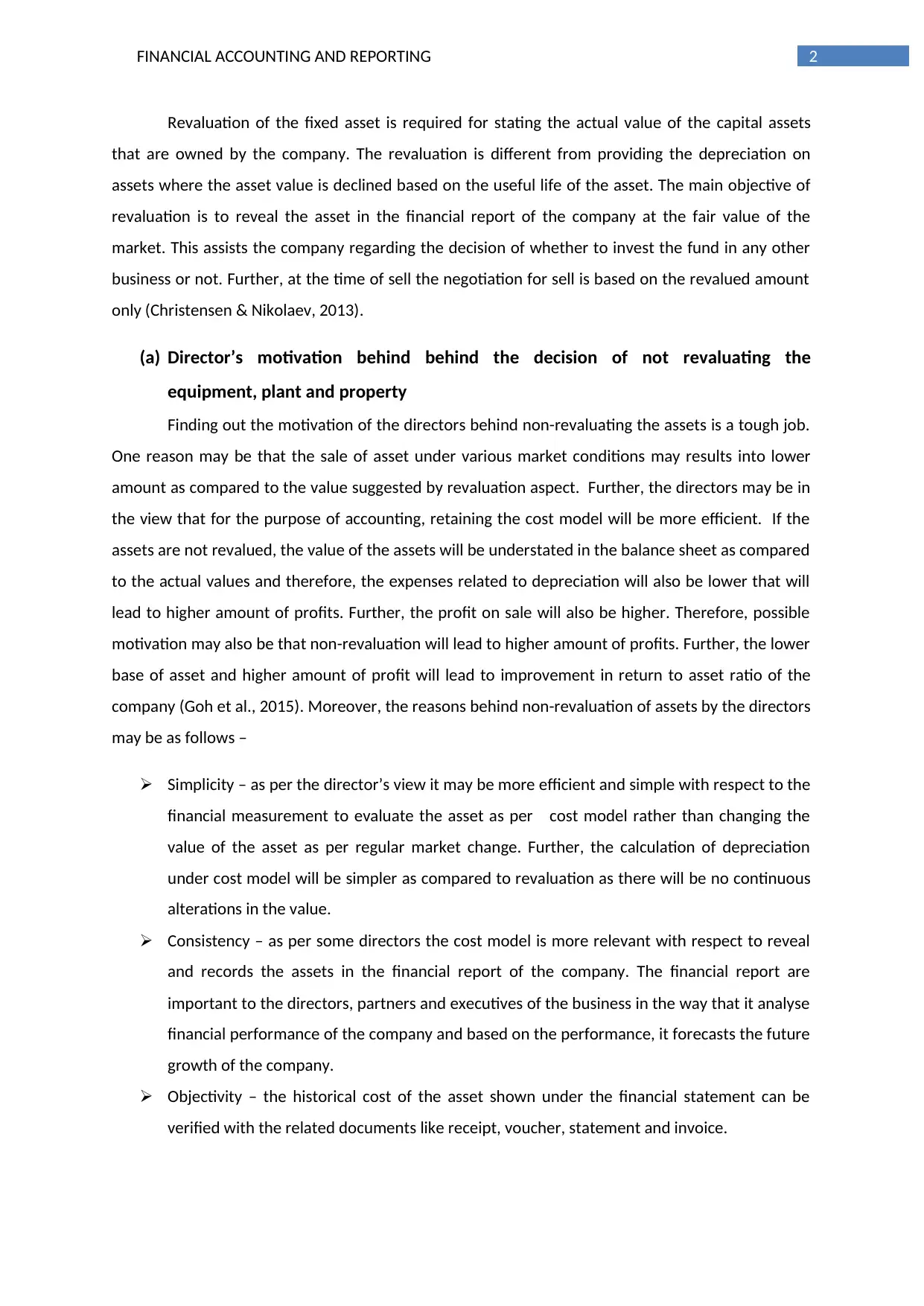
2FINANCIAL ACCOUNTING AND REPORTING
Revaluation of the fixed asset is required for stating the actual value of the capital assets
that are owned by the company. The revaluation is different from providing the depreciation on
assets where the asset value is declined based on the useful life of the asset. The main objective of
revaluation is to reveal the asset in the financial report of the company at the fair value of the
market. This assists the company regarding the decision of whether to invest the fund in any other
business or not. Further, at the time of sell the negotiation for sell is based on the revalued amount
only (Christensen & Nikolaev, 2013).
(a) Director’s motivation behind behind the decision of not revaluating the
equipment, plant and property
Finding out the motivation of the directors behind non-revaluating the assets is a tough job.
One reason may be that the sale of asset under various market conditions may results into lower
amount as compared to the value suggested by revaluation aspect. Further, the directors may be in
the view that for the purpose of accounting, retaining the cost model will be more efficient. If the
assets are not revalued, the value of the assets will be understated in the balance sheet as compared
to the actual values and therefore, the expenses related to depreciation will also be lower that will
lead to higher amount of profits. Further, the profit on sale will also be higher. Therefore, possible
motivation may also be that non-revaluation will lead to higher amount of profits. Further, the lower
base of asset and higher amount of profit will lead to improvement in return to asset ratio of the
company (Goh et al., 2015). Moreover, the reasons behind non-revaluation of assets by the directors
may be as follows –
Simplicity – as per the director’s view it may be more efficient and simple with respect to the
financial measurement to evaluate the asset as per cost model rather than changing the
value of the asset as per regular market change. Further, the calculation of depreciation
under cost model will be simpler as compared to revaluation as there will be no continuous
alterations in the value.
Consistency – as per some directors the cost model is more relevant with respect to reveal
and records the assets in the financial report of the company. The financial report are
important to the directors, partners and executives of the business in the way that it analyse
financial performance of the company and based on the performance, it forecasts the future
growth of the company.
Objectivity – the historical cost of the asset shown under the financial statement can be
verified with the related documents like receipt, voucher, statement and invoice.
Revaluation of the fixed asset is required for stating the actual value of the capital assets
that are owned by the company. The revaluation is different from providing the depreciation on
assets where the asset value is declined based on the useful life of the asset. The main objective of
revaluation is to reveal the asset in the financial report of the company at the fair value of the
market. This assists the company regarding the decision of whether to invest the fund in any other
business or not. Further, at the time of sell the negotiation for sell is based on the revalued amount
only (Christensen & Nikolaev, 2013).
(a) Director’s motivation behind behind the decision of not revaluating the
equipment, plant and property
Finding out the motivation of the directors behind non-revaluating the assets is a tough job.
One reason may be that the sale of asset under various market conditions may results into lower
amount as compared to the value suggested by revaluation aspect. Further, the directors may be in
the view that for the purpose of accounting, retaining the cost model will be more efficient. If the
assets are not revalued, the value of the assets will be understated in the balance sheet as compared
to the actual values and therefore, the expenses related to depreciation will also be lower that will
lead to higher amount of profits. Further, the profit on sale will also be higher. Therefore, possible
motivation may also be that non-revaluation will lead to higher amount of profits. Further, the lower
base of asset and higher amount of profit will lead to improvement in return to asset ratio of the
company (Goh et al., 2015). Moreover, the reasons behind non-revaluation of assets by the directors
may be as follows –
Simplicity – as per the director’s view it may be more efficient and simple with respect to the
financial measurement to evaluate the asset as per cost model rather than changing the
value of the asset as per regular market change. Further, the calculation of depreciation
under cost model will be simpler as compared to revaluation as there will be no continuous
alterations in the value.
Consistency – as per some directors the cost model is more relevant with respect to reveal
and records the assets in the financial report of the company. The financial report are
important to the directors, partners and executives of the business in the way that it analyse
financial performance of the company and based on the performance, it forecasts the future
growth of the company.
Objectivity – the historical cost of the asset shown under the financial statement can be
verified with the related documents like receipt, voucher, statement and invoice.
⊘ This is a preview!⊘
Do you want full access?
Subscribe today to unlock all pages.

Trusted by 1+ million students worldwide
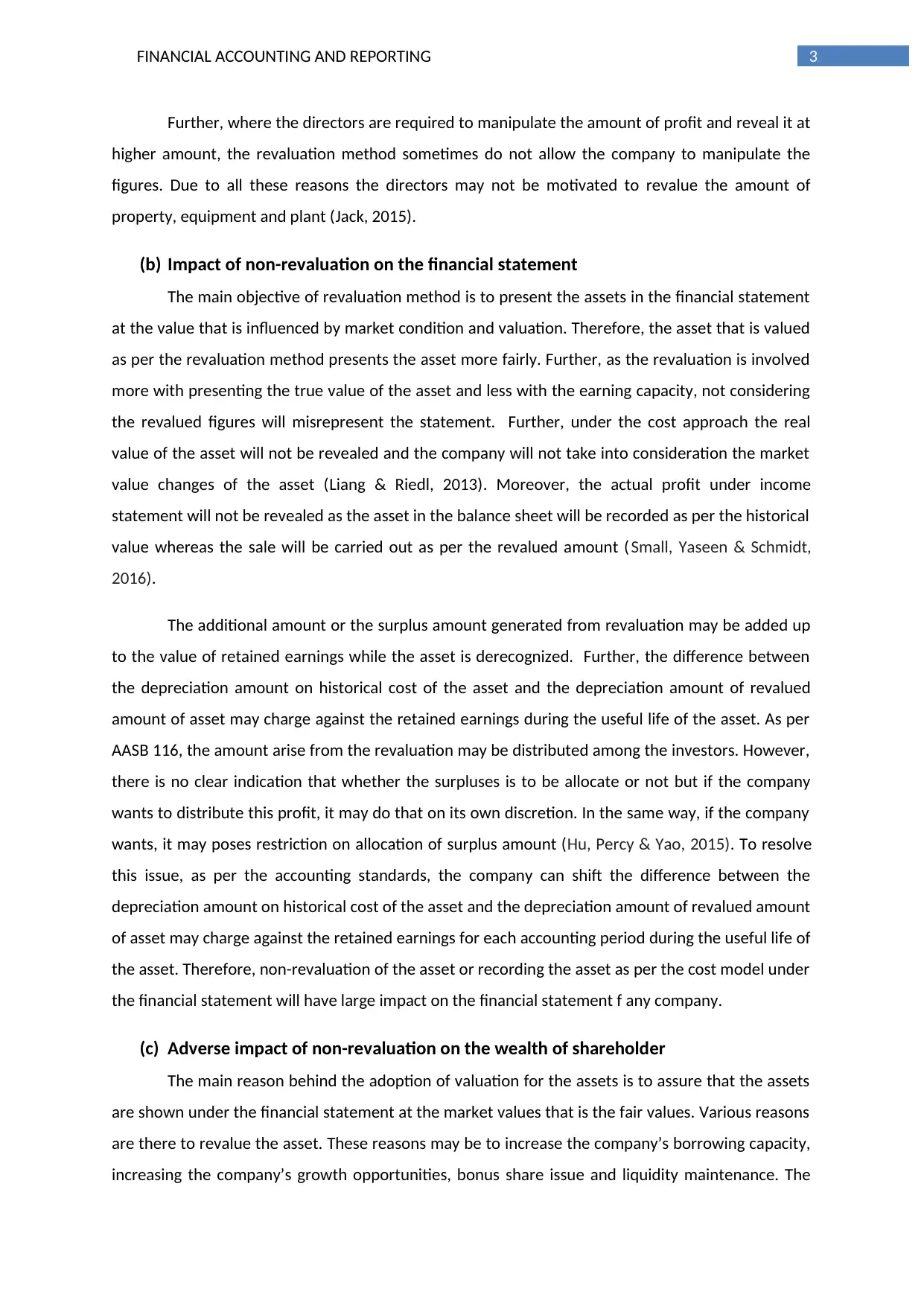
3FINANCIAL ACCOUNTING AND REPORTING
Further, where the directors are required to manipulate the amount of profit and reveal it at
higher amount, the revaluation method sometimes do not allow the company to manipulate the
figures. Due to all these reasons the directors may not be motivated to revalue the amount of
property, equipment and plant (Jack, 2015).
(b) Impact of non-revaluation on the financial statement
The main objective of revaluation method is to present the assets in the financial statement
at the value that is influenced by market condition and valuation. Therefore, the asset that is valued
as per the revaluation method presents the asset more fairly. Further, as the revaluation is involved
more with presenting the true value of the asset and less with the earning capacity, not considering
the revalued figures will misrepresent the statement. Further, under the cost approach the real
value of the asset will not be revealed and the company will not take into consideration the market
value changes of the asset (Liang & Riedl, 2013). Moreover, the actual profit under income
statement will not be revealed as the asset in the balance sheet will be recorded as per the historical
value whereas the sale will be carried out as per the revalued amount ( Small, Yaseen & Schmidt,
2016).
The additional amount or the surplus amount generated from revaluation may be added up
to the value of retained earnings while the asset is derecognized. Further, the difference between
the depreciation amount on historical cost of the asset and the depreciation amount of revalued
amount of asset may charge against the retained earnings during the useful life of the asset. As per
AASB 116, the amount arise from the revaluation may be distributed among the investors. However,
there is no clear indication that whether the surpluses is to be allocate or not but if the company
wants to distribute this profit, it may do that on its own discretion. In the same way, if the company
wants, it may poses restriction on allocation of surplus amount (Hu, Percy & Yao, 2015). To resolve
this issue, as per the accounting standards, the company can shift the difference between the
depreciation amount on historical cost of the asset and the depreciation amount of revalued amount
of asset may charge against the retained earnings for each accounting period during the useful life of
the asset. Therefore, non-revaluation of the asset or recording the asset as per the cost model under
the financial statement will have large impact on the financial statement f any company.
(c) Adverse impact of non-revaluation on the wealth of shareholder
The main reason behind the adoption of valuation for the assets is to assure that the assets
are shown under the financial statement at the market values that is the fair values. Various reasons
are there to revalue the asset. These reasons may be to increase the company’s borrowing capacity,
increasing the company’s growth opportunities, bonus share issue and liquidity maintenance. The
Further, where the directors are required to manipulate the amount of profit and reveal it at
higher amount, the revaluation method sometimes do not allow the company to manipulate the
figures. Due to all these reasons the directors may not be motivated to revalue the amount of
property, equipment and plant (Jack, 2015).
(b) Impact of non-revaluation on the financial statement
The main objective of revaluation method is to present the assets in the financial statement
at the value that is influenced by market condition and valuation. Therefore, the asset that is valued
as per the revaluation method presents the asset more fairly. Further, as the revaluation is involved
more with presenting the true value of the asset and less with the earning capacity, not considering
the revalued figures will misrepresent the statement. Further, under the cost approach the real
value of the asset will not be revealed and the company will not take into consideration the market
value changes of the asset (Liang & Riedl, 2013). Moreover, the actual profit under income
statement will not be revealed as the asset in the balance sheet will be recorded as per the historical
value whereas the sale will be carried out as per the revalued amount ( Small, Yaseen & Schmidt,
2016).
The additional amount or the surplus amount generated from revaluation may be added up
to the value of retained earnings while the asset is derecognized. Further, the difference between
the depreciation amount on historical cost of the asset and the depreciation amount of revalued
amount of asset may charge against the retained earnings during the useful life of the asset. As per
AASB 116, the amount arise from the revaluation may be distributed among the investors. However,
there is no clear indication that whether the surpluses is to be allocate or not but if the company
wants to distribute this profit, it may do that on its own discretion. In the same way, if the company
wants, it may poses restriction on allocation of surplus amount (Hu, Percy & Yao, 2015). To resolve
this issue, as per the accounting standards, the company can shift the difference between the
depreciation amount on historical cost of the asset and the depreciation amount of revalued amount
of asset may charge against the retained earnings for each accounting period during the useful life of
the asset. Therefore, non-revaluation of the asset or recording the asset as per the cost model under
the financial statement will have large impact on the financial statement f any company.
(c) Adverse impact of non-revaluation on the wealth of shareholder
The main reason behind the adoption of valuation for the assets is to assure that the assets
are shown under the financial statement at the market values that is the fair values. Various reasons
are there to revalue the asset. These reasons may be to increase the company’s borrowing capacity,
increasing the company’s growth opportunities, bonus share issue and liquidity maintenance. The
Paraphrase This Document
Need a fresh take? Get an instant paraphrase of this document with our AI Paraphraser
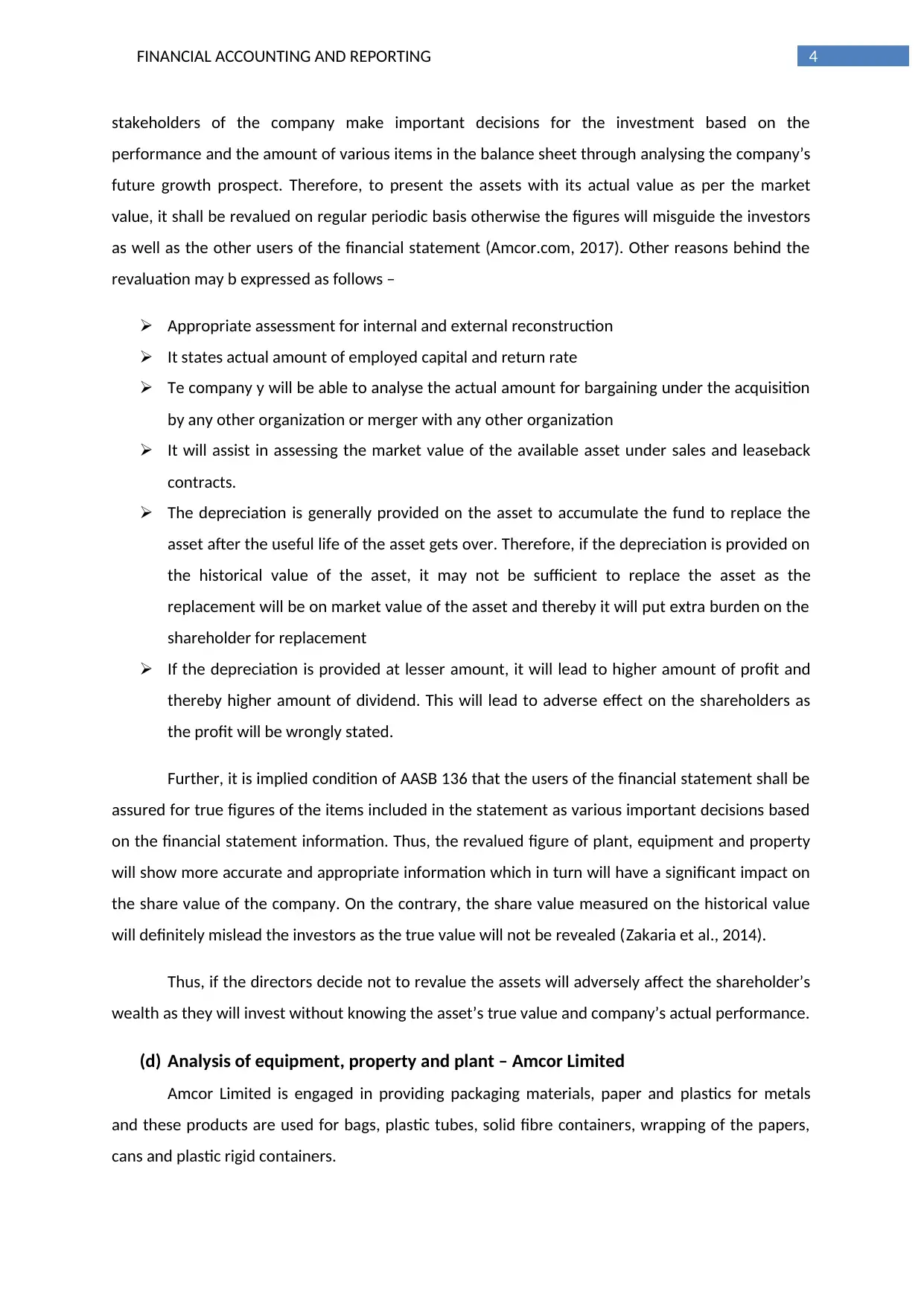
4FINANCIAL ACCOUNTING AND REPORTING
stakeholders of the company make important decisions for the investment based on the
performance and the amount of various items in the balance sheet through analysing the company’s
future growth prospect. Therefore, to present the assets with its actual value as per the market
value, it shall be revalued on regular periodic basis otherwise the figures will misguide the investors
as well as the other users of the financial statement (Amcor.com, 2017). Other reasons behind the
revaluation may b expressed as follows –
Appropriate assessment for internal and external reconstruction
It states actual amount of employed capital and return rate
Te company y will be able to analyse the actual amount for bargaining under the acquisition
by any other organization or merger with any other organization
It will assist in assessing the market value of the available asset under sales and leaseback
contracts.
The depreciation is generally provided on the asset to accumulate the fund to replace the
asset after the useful life of the asset gets over. Therefore, if the depreciation is provided on
the historical value of the asset, it may not be sufficient to replace the asset as the
replacement will be on market value of the asset and thereby it will put extra burden on the
shareholder for replacement
If the depreciation is provided at lesser amount, it will lead to higher amount of profit and
thereby higher amount of dividend. This will lead to adverse effect on the shareholders as
the profit will be wrongly stated.
Further, it is implied condition of AASB 136 that the users of the financial statement shall be
assured for true figures of the items included in the statement as various important decisions based
on the financial statement information. Thus, the revalued figure of plant, equipment and property
will show more accurate and appropriate information which in turn will have a significant impact on
the share value of the company. On the contrary, the share value measured on the historical value
will definitely mislead the investors as the true value will not be revealed (Zakaria et al., 2014).
Thus, if the directors decide not to revalue the assets will adversely affect the shareholder’s
wealth as they will invest without knowing the asset’s true value and company’s actual performance.
(d) Analysis of equipment, property and plant – Amcor Limited
Amcor Limited is engaged in providing packaging materials, paper and plastics for metals
and these products are used for bags, plastic tubes, solid fibre containers, wrapping of the papers,
cans and plastic rigid containers.
stakeholders of the company make important decisions for the investment based on the
performance and the amount of various items in the balance sheet through analysing the company’s
future growth prospect. Therefore, to present the assets with its actual value as per the market
value, it shall be revalued on regular periodic basis otherwise the figures will misguide the investors
as well as the other users of the financial statement (Amcor.com, 2017). Other reasons behind the
revaluation may b expressed as follows –
Appropriate assessment for internal and external reconstruction
It states actual amount of employed capital and return rate
Te company y will be able to analyse the actual amount for bargaining under the acquisition
by any other organization or merger with any other organization
It will assist in assessing the market value of the available asset under sales and leaseback
contracts.
The depreciation is generally provided on the asset to accumulate the fund to replace the
asset after the useful life of the asset gets over. Therefore, if the depreciation is provided on
the historical value of the asset, it may not be sufficient to replace the asset as the
replacement will be on market value of the asset and thereby it will put extra burden on the
shareholder for replacement
If the depreciation is provided at lesser amount, it will lead to higher amount of profit and
thereby higher amount of dividend. This will lead to adverse effect on the shareholders as
the profit will be wrongly stated.
Further, it is implied condition of AASB 136 that the users of the financial statement shall be
assured for true figures of the items included in the statement as various important decisions based
on the financial statement information. Thus, the revalued figure of plant, equipment and property
will show more accurate and appropriate information which in turn will have a significant impact on
the share value of the company. On the contrary, the share value measured on the historical value
will definitely mislead the investors as the true value will not be revealed (Zakaria et al., 2014).
Thus, if the directors decide not to revalue the assets will adversely affect the shareholder’s
wealth as they will invest without knowing the asset’s true value and company’s actual performance.
(d) Analysis of equipment, property and plant – Amcor Limited
Amcor Limited is engaged in providing packaging materials, paper and plastics for metals
and these products are used for bags, plastic tubes, solid fibre containers, wrapping of the papers,
cans and plastic rigid containers.
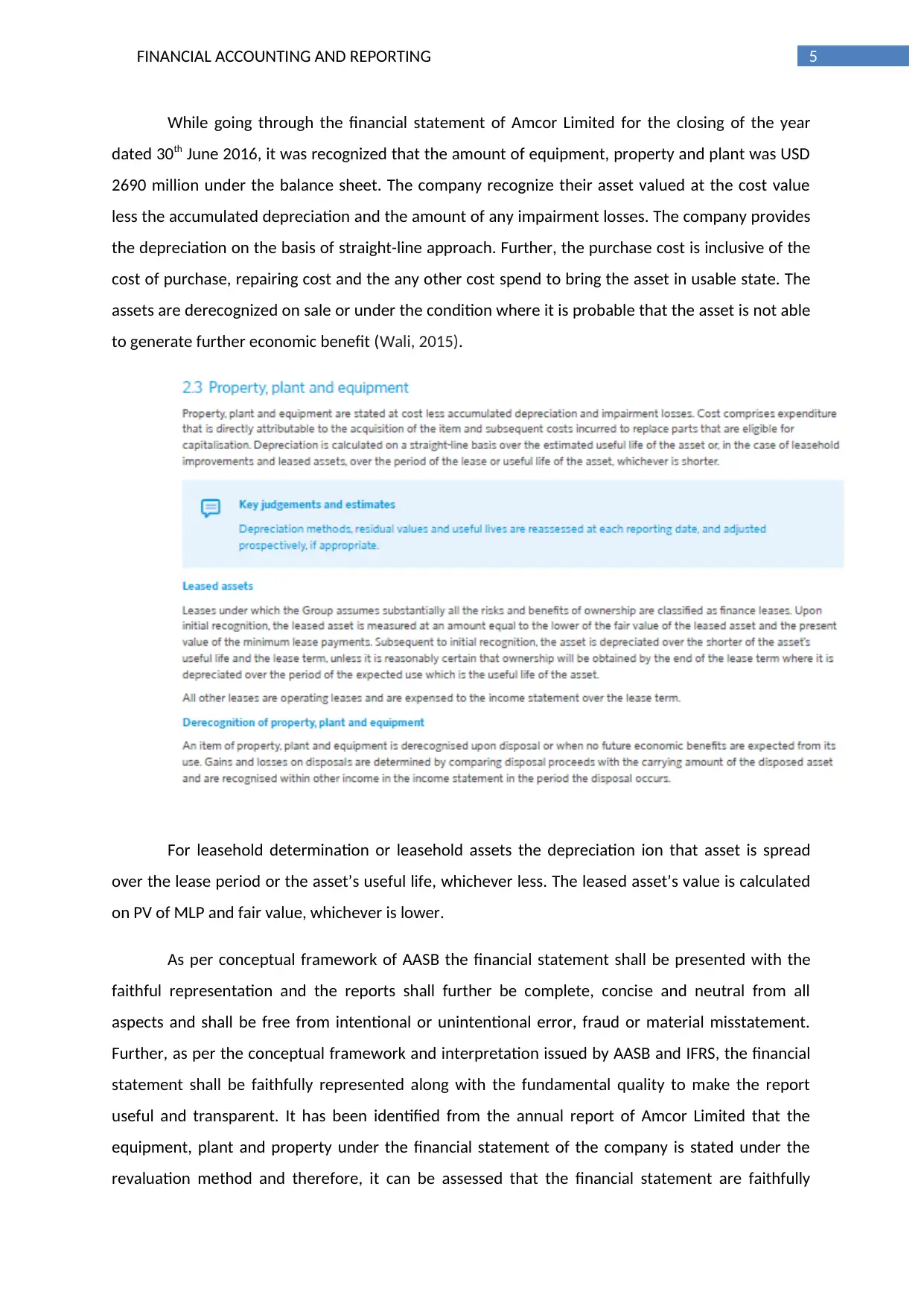
5FINANCIAL ACCOUNTING AND REPORTING
While going through the financial statement of Amcor Limited for the closing of the year
dated 30th June 2016, it was recognized that the amount of equipment, property and plant was USD
2690 million under the balance sheet. The company recognize their asset valued at the cost value
less the accumulated depreciation and the amount of any impairment losses. The company provides
the depreciation on the basis of straight-line approach. Further, the purchase cost is inclusive of the
cost of purchase, repairing cost and the any other cost spend to bring the asset in usable state. The
assets are derecognized on sale or under the condition where it is probable that the asset is not able
to generate further economic benefit (Wali, 2015).
For leasehold determination or leasehold assets the depreciation ion that asset is spread
over the lease period or the asset’s useful life, whichever less. The leased asset’s value is calculated
on PV of MLP and fair value, whichever is lower.
As per conceptual framework of AASB the financial statement shall be presented with the
faithful representation and the reports shall further be complete, concise and neutral from all
aspects and shall be free from intentional or unintentional error, fraud or material misstatement.
Further, as per the conceptual framework and interpretation issued by AASB and IFRS, the financial
statement shall be faithfully represented along with the fundamental quality to make the report
useful and transparent. It has been identified from the annual report of Amcor Limited that the
equipment, plant and property under the financial statement of the company is stated under the
revaluation method and therefore, it can be assessed that the financial statement are faithfully
While going through the financial statement of Amcor Limited for the closing of the year
dated 30th June 2016, it was recognized that the amount of equipment, property and plant was USD
2690 million under the balance sheet. The company recognize their asset valued at the cost value
less the accumulated depreciation and the amount of any impairment losses. The company provides
the depreciation on the basis of straight-line approach. Further, the purchase cost is inclusive of the
cost of purchase, repairing cost and the any other cost spend to bring the asset in usable state. The
assets are derecognized on sale or under the condition where it is probable that the asset is not able
to generate further economic benefit (Wali, 2015).
For leasehold determination or leasehold assets the depreciation ion that asset is spread
over the lease period or the asset’s useful life, whichever less. The leased asset’s value is calculated
on PV of MLP and fair value, whichever is lower.
As per conceptual framework of AASB the financial statement shall be presented with the
faithful representation and the reports shall further be complete, concise and neutral from all
aspects and shall be free from intentional or unintentional error, fraud or material misstatement.
Further, as per the conceptual framework and interpretation issued by AASB and IFRS, the financial
statement shall be faithfully represented along with the fundamental quality to make the report
useful and transparent. It has been identified from the annual report of Amcor Limited that the
equipment, plant and property under the financial statement of the company is stated under the
revaluation method and therefore, it can be assessed that the financial statement are faithfully
⊘ This is a preview!⊘
Do you want full access?
Subscribe today to unlock all pages.

Trusted by 1+ million students worldwide
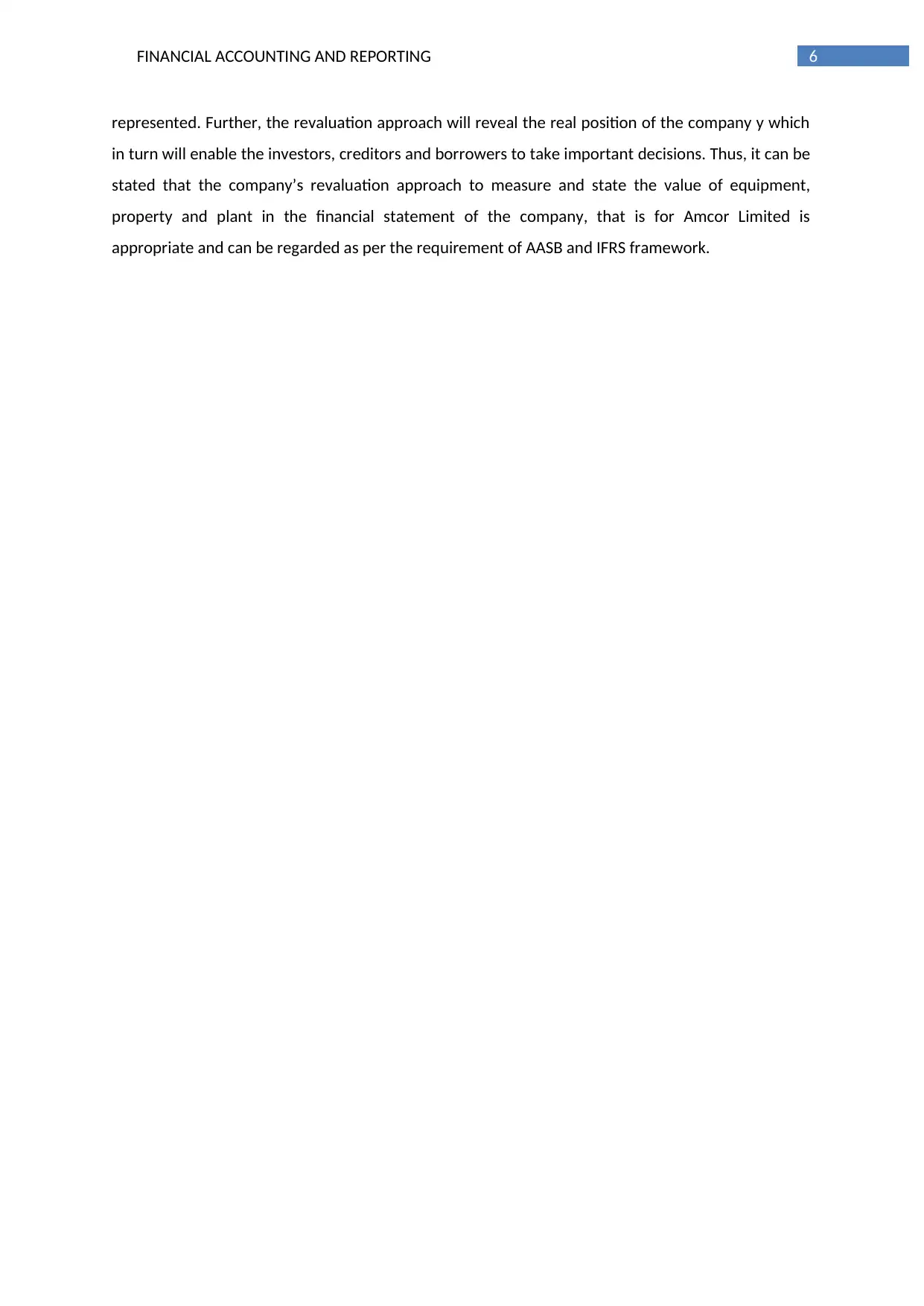
6FINANCIAL ACCOUNTING AND REPORTING
represented. Further, the revaluation approach will reveal the real position of the company y which
in turn will enable the investors, creditors and borrowers to take important decisions. Thus, it can be
stated that the company’s revaluation approach to measure and state the value of equipment,
property and plant in the financial statement of the company, that is for Amcor Limited is
appropriate and can be regarded as per the requirement of AASB and IFRS framework.
represented. Further, the revaluation approach will reveal the real position of the company y which
in turn will enable the investors, creditors and borrowers to take important decisions. Thus, it can be
stated that the company’s revaluation approach to measure and state the value of equipment,
property and plant in the financial statement of the company, that is for Amcor Limited is
appropriate and can be regarded as per the requirement of AASB and IFRS framework.
Paraphrase This Document
Need a fresh take? Get an instant paraphrase of this document with our AI Paraphraser
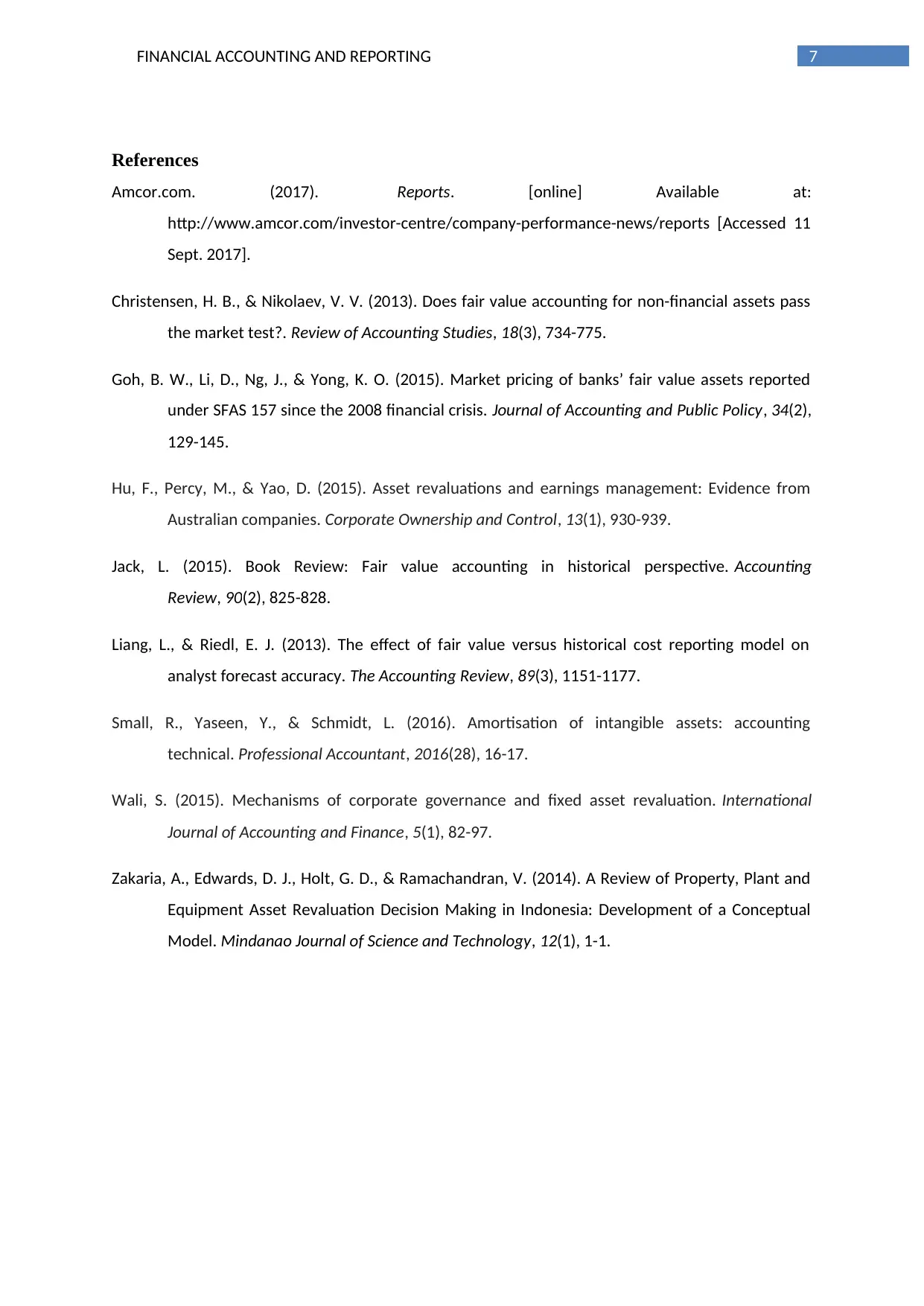
7FINANCIAL ACCOUNTING AND REPORTING
References
Amcor.com. (2017). Reports. [online] Available at:
http://www.amcor.com/investor-centre/company-performance-news/reports [Accessed 11
Sept. 2017].
Christensen, H. B., & Nikolaev, V. V. (2013). Does fair value accounting for non-financial assets pass
the market test?. Review of Accounting Studies, 18(3), 734-775.
Goh, B. W., Li, D., Ng, J., & Yong, K. O. (2015). Market pricing of banks’ fair value assets reported
under SFAS 157 since the 2008 financial crisis. Journal of Accounting and Public Policy, 34(2),
129-145.
Hu, F., Percy, M., & Yao, D. (2015). Asset revaluations and earnings management: Evidence from
Australian companies. Corporate Ownership and Control, 13(1), 930-939.
Jack, L. (2015). Book Review: Fair value accounting in historical perspective. Accounting
Review, 90(2), 825-828.
Liang, L., & Riedl, E. J. (2013). The effect of fair value versus historical cost reporting model on
analyst forecast accuracy. The Accounting Review, 89(3), 1151-1177.
Small, R., Yaseen, Y., & Schmidt, L. (2016). Amortisation of intangible assets: accounting
technical. Professional Accountant, 2016(28), 16-17.
Wali, S. (2015). Mechanisms of corporate governance and fixed asset revaluation. International
Journal of Accounting and Finance, 5(1), 82-97.
Zakaria, A., Edwards, D. J., Holt, G. D., & Ramachandran, V. (2014). A Review of Property, Plant and
Equipment Asset Revaluation Decision Making in Indonesia: Development of a Conceptual
Model. Mindanao Journal of Science and Technology, 12(1), 1-1.
References
Amcor.com. (2017). Reports. [online] Available at:
http://www.amcor.com/investor-centre/company-performance-news/reports [Accessed 11
Sept. 2017].
Christensen, H. B., & Nikolaev, V. V. (2013). Does fair value accounting for non-financial assets pass
the market test?. Review of Accounting Studies, 18(3), 734-775.
Goh, B. W., Li, D., Ng, J., & Yong, K. O. (2015). Market pricing of banks’ fair value assets reported
under SFAS 157 since the 2008 financial crisis. Journal of Accounting and Public Policy, 34(2),
129-145.
Hu, F., Percy, M., & Yao, D. (2015). Asset revaluations and earnings management: Evidence from
Australian companies. Corporate Ownership and Control, 13(1), 930-939.
Jack, L. (2015). Book Review: Fair value accounting in historical perspective. Accounting
Review, 90(2), 825-828.
Liang, L., & Riedl, E. J. (2013). The effect of fair value versus historical cost reporting model on
analyst forecast accuracy. The Accounting Review, 89(3), 1151-1177.
Small, R., Yaseen, Y., & Schmidt, L. (2016). Amortisation of intangible assets: accounting
technical. Professional Accountant, 2016(28), 16-17.
Wali, S. (2015). Mechanisms of corporate governance and fixed asset revaluation. International
Journal of Accounting and Finance, 5(1), 82-97.
Zakaria, A., Edwards, D. J., Holt, G. D., & Ramachandran, V. (2014). A Review of Property, Plant and
Equipment Asset Revaluation Decision Making in Indonesia: Development of a Conceptual
Model. Mindanao Journal of Science and Technology, 12(1), 1-1.
1 out of 8
Related Documents
Your All-in-One AI-Powered Toolkit for Academic Success.
+13062052269
info@desklib.com
Available 24*7 on WhatsApp / Email
![[object Object]](/_next/static/media/star-bottom.7253800d.svg)
Unlock your academic potential
Copyright © 2020–2025 A2Z Services. All Rights Reserved. Developed and managed by ZUCOL.



